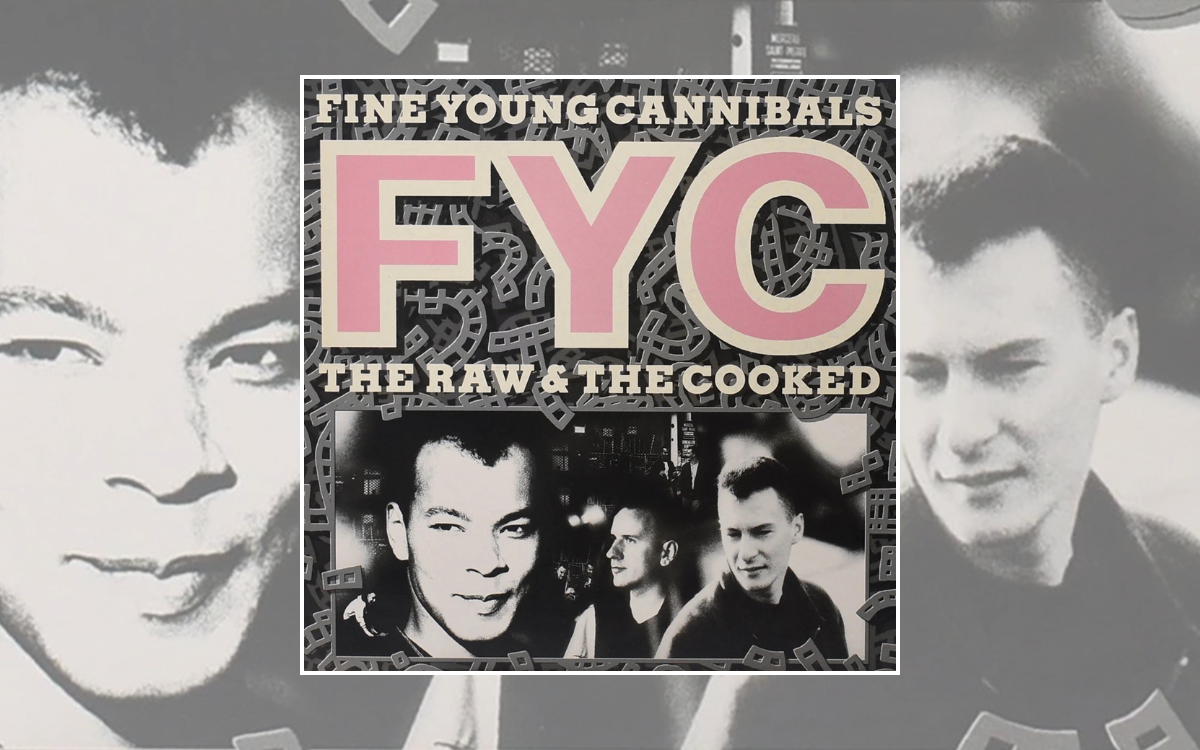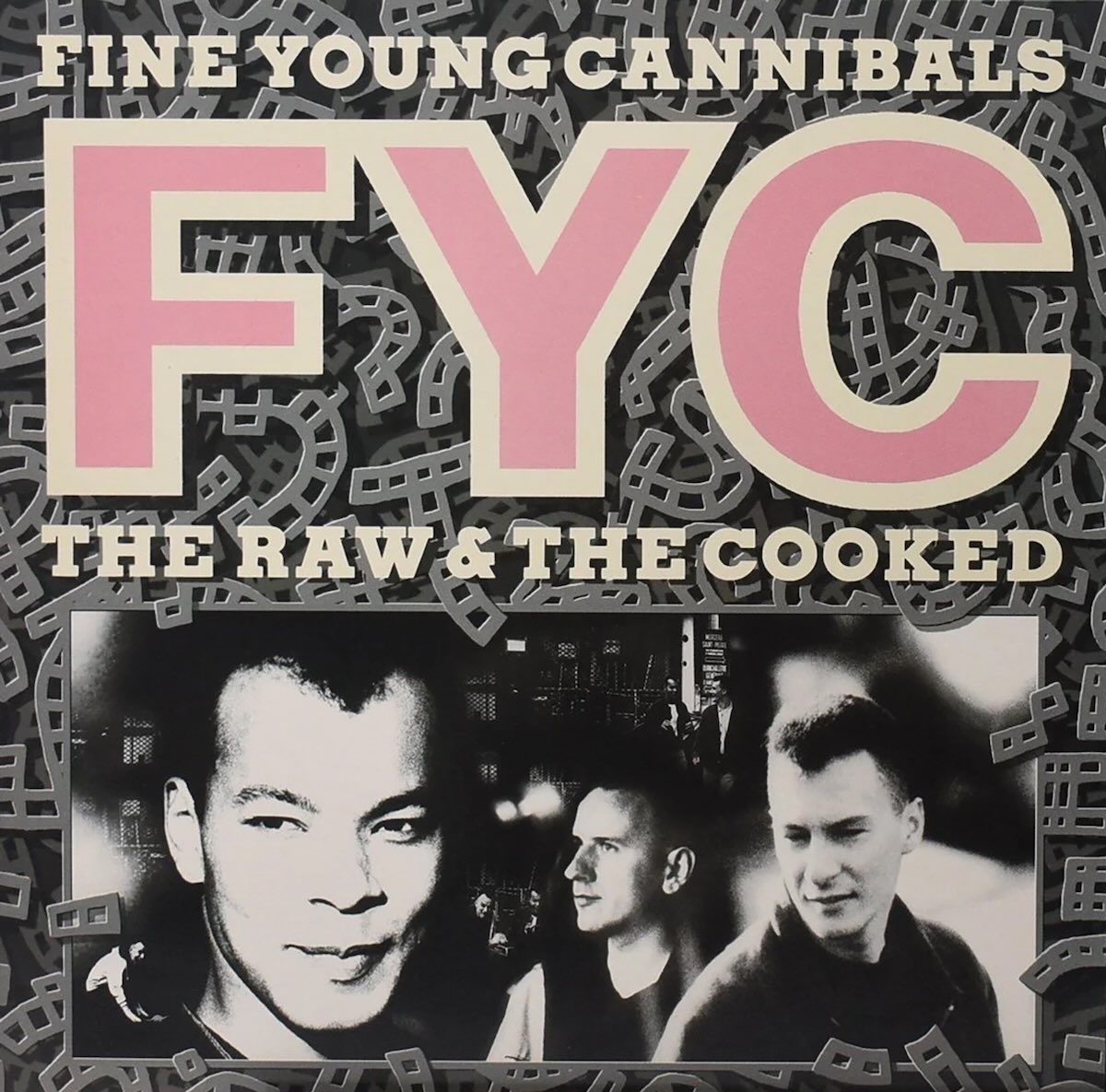Band’s second long-player defied all the odds to become a worldwide No.1 pop sensation

The Fine Young Cannibals’ eclectic second album, The Raw & The Cooked, was a hotchpotch of styles and sessions, that defied all the odds to become a worldwide No.1 sensation
For a brief moment in 1989, the Fine Young Cannibals were the biggest band on the planet. The Birmingham trio scored a global No.1 album, with two consecutive singles that topped the Billboard Hot 100 chart. But, as quickly as they had scaled such dizzying heights, they swiftly vanished into obscurity. Why did this seemingly unstoppable force implode at their peak? The story of The Raw & The Cooked is as perplexing as it is unlikely – one of sonic invention, serendipitous chemistry, and the inescapable burden of suddenly having it all.
Beat Goes On
When Birmingham ska revivalists, The Beat folded in 1983, the splinter outfit tipped for success was General Public – a supergroup of sorts, comprising frontmen Dave Wakeling and Ranking Roger, alongside a post-Clash Mick Jones, plus alumni of The Specials and Dexys Midnight Runners. They shot out of the blocks first, with the single, Tenderness, bringing early promise and chart success.
But in an unexpected twist, it was the sidemen – guitarist Andy Cox and bassist David Steele – who would ultimately eclipse their former bandmates. Searching in vain for a frontman, an optimistic ad campaign yielded hundreds of cassette submissions without success.
But sometimes, the thing you’ve been looking for is right under your nose all along. Having scoured the globe, the duo landed back where they started: in the Midlands.
Enter Roland Gift, a Birmingham-born musician and familiar face from the fellow ska group Akrylykz, with whom The Beat had toured previously. Besides their shared musical lineage, it was a mutual appreciation of 60s soul (Otis Redding, Sam Cooke, Al Green) that would be the spark-off point of the new venture. Fine Young Cannibals were born.
Their early output melded new wave energy with jazzy interludes, Mod stylings and Northern Soul. Rounding it all off is Roland’s trademark voice – slipping between a soulful falsetto that quivers on the edge of breaking, and a rich baritone.
Their self-titled debut laced with subtle political overtones landed in 1985 to moderate acclaim and a UK Top 10 single, Johnny Come Home. But any sense of momentum was stalled by the long gestation of its follow-up. It took a glacial four years to deliver – a sluggishly slow pace for a newly-launched group hoping to consolidate their fragile position.
Many bands play out their entire careers in that timeframe. But it was worth the wait, ultimately birthing one of the decade’s most eclectic and intriguing pop records.
Culinary Alchemy
Playfully expanding on the cannibal concept, the record takes its title from a French-language, Amerindian tribal culture study, Le Cru et le Cuit, by anthropologist, Claude Lévi-Strauss. To quote the author, he examines how the duality of terms such as ‘raw’ and ‘cooked’ serve “as conceptual tools for the formation of abstract notions.” On the face of it, a somewhat highbrow concept to inspire a pop record largely concerned with boy-meets-girl scenarios.
As such, the record is split into two halves, each representing a distinct mood. The ‘Raw’ side leans towards stripped-back soul influences, while the ‘Cooked’ features more slickly-produced arrangements. Certainly, the stylistic shifts are palpable, albeit integrated throughout, rather than through any obvious delineation between the two opposing halves of the disc.
With a whopping eight of the 10 tracks released as singles somewhere in the world, The Raw & The Cooked is essentially a greatest hits record.
Indeed, while ostensibly presented as a new studio album, it was actually a compilation of sorts; a patchwork of disparate sessions, hastily stitched together into a marketable product. Almost half its material was previously recorded for other projects, and relatively old hat by the time of its eventual release.
One reason for its delay was the band’s various film project detours. Gift had taken an unexpected acting role in the 1987 film, Sammy And Rosie Get Laid. In the same year, the whole trio were cast as a nightclub band in the movie, Tin Men. They duly supplied four songs, produced in a consciously throwback soul style, as befitting the film’s 1963 setting: Social Security, Good Thing, As Hard As It Is and Tell Me What.
They had also previously recorded a cover of the Buzzcocks’ hit Ever Fallen In Love for Jonathan Demme’s 1986 romp, Something Wild. Killing two birds with the one stone, they simply hoovered up four of these soundtrack songs and incorporated them into the would-be album.
Purple Reign
Unshackled from writing to a specific brief, the band’s remaining self-produced tracks showcased a notably innovative, forward-thinking side. They ventured into acid house (Don’t Let It Get You Down), and experimented with sampled drum loops to create a completely fresh, proto-trip-hop sound (I’m Not The Man I Used To Be).
There was no problem with the quality of the self-produced cuts – only their slow pace at delivering them, around all the other distractions. So, the label insisted upon enlisting an outside producer to sharpen the focus and finally drag the record over the line. The band were asked for preferences. Their response? ‘We want Prince.’
To even suggest that such an untouchable superstar – then in his mid-80s globe-straddling prime – might take on their production duties was either a sign of sheer gall, or otherwise (almost certainly) – a flippant wind-up to troll the label for laying on the pressure. Too ridiculously unattainable ever to be considered a realistic possibility, akin to demanding that Basquiat design the cover art and Schumacher be their chauffeur. Ultimately, they got the next best thing, and perhaps the better match: Prince’s right-hand man and producer David Z – the brother of The Revolution’s drummer Bobby.
David Z had the Minneapolis Sound down, with a CV that included hits by Jody Watley, Sheila E and Prince himself. More importantly, the pairing enabled them to collaborate on a more even keel than would ever have been possible with The Purple One.
Under Z’s tutelage, they retained their core identity, yet with added turbo chargers. They also had all the high-tech wizardry of the recently completed Paisley Park studio at their disposal.
What’s more, decamping to the relatively isolated Minneapolis outskirts came with an added practical advantage: captive musicians with no other option than to get down to business and record. To maximise the recording sessions, ideas were sent back and forth in advance to David Z, who made suggestions and brought commercial polish.
His brightest move was to recognise the potential of a rough diamond, titled She’s My Baby, which the band had dismissed as too throwaway to bother pursuing.
On Z’s insistence, they reshaped it from its innocuous fluffy sentiment to the immediately more compelling notion: She Drives Me Crazy. Powered by that colossal, cranium-shattering snare drum, the song and its characteristic sound swiftly became ubiquitous. It proved integral in elevating Fine Young Cannibals from mid-tier hopefuls to world superstars.
With two more Minneapolis tracks in the can, the album was complete.
Global Success
The Raw & The Cooked sold by the bucketload, going triple platinum in the UK and shifting two million units in the US alone. The No.1 Stateside success of She Drives Me Crazy was repeated by Good Thing, proving they were no mere one-trick pony. The LP picked up a Grammy nomination, and they performed at the 1990 awards ceremony. They would scoop two Brit Awards that same year, for Best British Album and Best British Group.
What’s most curious is that, at the top of their game, they suddenly disappeared – almost without a trace. Rather than capitalising with another studio album, they simply exited stage left.
FYC disbanded in 1992, reuniting only briefly in 1996 for a greatest hits. Speaking to the Harrogate Advertiser, Gift later recalled: “They kept saying to us our next record had to be even bigger, which was really stupid. That was one of the main things that killed it for me.”
Rather than fuelling their ambition, their unprecedented global success seemed only to stifle it. They had been reduced to a product; one burdened with sky-high expectations. Roland also hinted at a deeper philosophical choice.
In a 2015 backstage interview at Absolute 80s Festival, Gift admitted that he tires of doing the same thing repeatedly: oversaturation simply quashes the very qualities that make something special in the first place. Better to bow out on their own terms than keep chasing hits with diminishing returns.
Not Fade Away
Still, She Drives Me Crazy refuses to fade. It will occasionally blast out of the radio, and floor you with its potent brilliance. It just cuts straight through all the noise.
The track continues to pop up in movies, television shows, and even designer campaigns: a recent Chanel handbag ad, featuring Dua Lipa and K-pop star Jennie of BLACKPINK, has brought the track to a whole new generation. It’s been covered by everyone from Dolly Parton and Tom Jones to The Muppets. It has also received that ultimate pop zeitgeist seal of approval: a ‘Weird Al’ Yankovic parody (She Drives Like Crazy).
As is so often the way, their biggest hit was something of a red herring. Sure, it’s three-and-a-half minutes of pop perfection. But delving beyond that, there are plenty more substantial, emotionally resonant and musically daring cuts to feast upon.
Fine Young Cannibals remain one of pop’s strangest paradoxes: a band that became world-beaters almost in spite of themselves, only to then walk away. In many ways, that’s key to their mystique. They represent a moment in time, and there remains something enigmatic about them, having largely shunned the spotlight since. On the international stage, they seemingly arose out of nowhere.
Yet while touted worldwide as the hot ‘new’ thing, they were, of course, already veterans by the time they hit the big time.
FYC are the living embodiment of the adage that it takes 10 years to become an overnight success. When their moment did finally come, they burned bright, burned fast, and left behind a near perfect testament. And sometimes, that’s enough.

The Songs
She Drives Me Crazy
Bom. Bah. Bom-bom. Bah. Bom-bom. Bah. Bom-bom. Bah… An instantly recognisable drum pattern that introduces one of the biggest tracks of 1989. The solid thud of the kick drum sparring against that thundercrack snare, making way for those jagged guitars; it’s the ultimate earworm that transports the listener back to a certain time and place. Producer David Z went to ridiculous lengths to achieve that characteristic sound, and when Gift’s utterly distinctive nasal falsetto enters in the hook, it’s surely one of the most gratifying pay-offs in pop history. Released on Boxing Day 1988, She Drives Me Crazy was, of course, a huge worldwide smash, hitting the top spot on three continents, in countries including Australia, New Zealand, Canada, US (a Billboard No.1 for one week in April 1989), Spain and Austria – though, curiously not the UK, where it achieved a measly Top 5 showing. It’s been covered umpteen times. Though each is a fitting tribute, the overriding effect is to make you yearn longingly for the original. Its prevalence in pop culture extended to a Pepsi ad, which famously commandeered the signature snare. It even directly inspired Taylor Swift’s 1989 album (having been released in the year she was born).
Good Thing
Thanks to his pioneering work on that massive trademark lead single, the album’s entire production is often erroneously credited to David Z. But it’s worth emphasising that he was only responsible for producing three of the 10 tracks. Credit is due to the band members themselves for their production nous, and Good Thing is a clear example. Written as a 1960s pastiche for the film Tin Men, it showcases an authentic Motown and Northern Soul sound. The throwback vibe is completed by Jools Holland tinkering on the ivories for a rousing boogie-woogie solo. (Jools and Roland would later tour together with the former’s big band.) Good Thing has since appeared in various other films and TV shows. It proved another huge hit across North America, giving FYC their second No.1 both in the US and Canada. Indeed, as with its predecessor, the singles performed better Stateside than they did on the band’s own turf. At times elsewhere, Gift’s voice is just a whisker short of comedic (veering close to Orville the Duck). On this track, the singer showcases a deep, gritty and particularly full-bodied voice that fits the mood perfectly, grunting and rasping with earthy soul.
I’m Not The Man I Used To Be
Another self-produced track, this innovative gem is built around a slowed-down sample of the ubiquitous Funky Drummer break (courtesy of James Brown). The result could be classed as proto trip-hop, reminiscent of early Massive Attack, with its beautifully understated soulful vocals, set to a hypnotic shuffling beat. It’s at once deep-rooted in tradition, yet decidedly cutting edge. I’m Not The Man I Used To Be laughs in the face of ‘plastic soul’ criticisms sometimes directed at bands such as FYC. It’s a thoroughly modern, forward-thinking update on classic soul; sophisticated, yet exuding a street sensibility. The combination of the frenetic rhythms against Roland’s world-weary vocal creates a feeling that’s deeply forlorn, entrenched with a sense of longing and regret.
I’m Not Satisfied
Another David Z production, I’m Not Satisfied is crafted very much from the same mould as She Drives Me Crazy. It shares that same identifiable thunderclap snare in the backbeat, though a generally busier arrangement, lacking the minimalist simplicity of its counterpart. Though not quite reaching the same heights, it’s a solid cut, with gospel backing vocals in the chorus, leading into a snazzy Hammond organ solo. It presents the band at their most funky and jaunty, fading out with a wailing ad-lib outro from Roland, as he screams, “I’m not satisfied…” We believe him.
Tell Me What
The next of the three 60s soul throwbacks from Tin Men, Tell Me What is an absolutely gorgeous, dreamy doo-wop pop number, with lovely backing vocals, and a soulful turn from Roland Gift. It has an Otis Redding My Girl kind of vibe, and wins no points for originality, but who cares when it sounds this great.
Don’t Look Back
Said to be inspired by 60s jangle pop legends, The Byrds; yet, with its driving drums, Don’t Look Back is closer to the kind of up-tempo heartland rocker Bruce Springsteen would trot out in his mid-80s prime, somewhere between Glory Days and Hungry Heart (with a little Johnny Marr jangle thrown in for good measure). While FYC are particularly tricky to pigeonhole for radio pluggers, it feels like this track was specifically tailor-made for American AM drivetime rock radio. As such, it feels quite incongruous compared to the rest of the record. Another jukebox throwback, but more spit’n’sawdust, rock’n’roll, as opposed to Motown. The style suits Roland vocally, but its brash production feels somewhat dated now. (Pop quiz fact: backing vocals are provided by fellow Brummie, Simon Fowler, who went on to front Ocean Colour Scene.)
It’s Ok (It’s Alright)
The slick production is again immediately identifiable as one of the three David Z Minneapolis tracks. It’s a ballad, of sorts, yet with all the funky bits, like something you’d hear on Thriller with the slinky guitars vaguely recalling Billie Jean.
Don’t Let It Get You Down
Perhaps the most experimental track on the record, FYC venture into acid house, via the characteristically squelchy Roland TR-303 bass synth. The electro flourishes are contrasted by some very jazzy trumpet, courtesy of Graeme Hamilton, who played on Johnny Come Home. Some commentators have compared the sound to a video game, and it does indeed have that retro 8-bit gaming vibe. Roland sings at the squeakier end of his register, with some particularly high-pitched falsetto. The dance sensibility shares some DNA with the Cox/Steele track, Tired Of Getting Pushed Around, a surprise Top 20 hit, imaginatively released as ‘Two Men, A Drum Machine And A Trumpet’, which pretty much does what it says on the tin.
As Hard As It Is
The final Tin Men track is – true to form – like an old, lost soul classic. Gift adopts his deep baritone voice to great effect, over a doo-wop instrumental, complete with shoo-wop backing vocals, shimmering guitars, and shrieking sax solo, that exudes its raw emotion with a slight squeak on exit. One of the self-produced tracks on the record, As Hard As It Is shows their depth of musicality.
Ever Fallen In Love
To those accustomed to the visceral, punky, youthful reckless abandon of the Buzzcocks’ original, this cover initially jars horribly. In comparison, its relatively drudgy, plodding pace and slick production feel decidedly incongruous. But, beneath those trashy guitars, Pete Shelley’s teen anthem was always a cracking pop song at heart, and once you recalibrate to enjoy it on its own terms, FYC’s take transforms into something worthy of merit. Recorded for the film Something Wild, this vaguely disco, soulful interpretation was produced by Talking Heads’ Jerry Harrison.
Subscribe to Classic Pop magazine here
Classic Pop may earn commission from the links on this page, but we only feature products we think you will enjoy.


